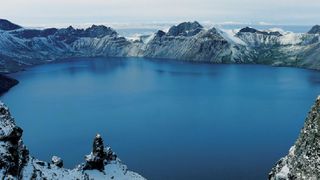How a catastrophic volcanic eruption on the North Korea border created 'Heaven Lake'
One of the most dramatic volcanic eruptions in history occurred more than 1,000 years ago. Scientists are still piecing together the aftermath.

In the year 946 CE, the Changbaishan-Tianchi volcano, on the border between China and North Korea, erupted ferociously. The eruption released dozens of cubic kilometers of magma and triggered a massive flood from the lake atop the volcano's summit, known today as Heaven Lake. Evidence of the flood can still be seen in the form of boulders and smaller rocks that washed down from the upper reaches of the volcano.
Changbaishan-Tianchi, known as Baekdu in Korean, could erupt again, so volcanologists want to understand the risks it poses. To investigate the catastrophic flood that followed the 946 eruption, Qin et al. dug into the layered deposits from the volcano. Their work suggests that at least 1 cubic kilometer of water spilled from the volcano's caldera, causing sediment to erode at rates as high as 34 meters per hour over about 3 hours.
The researchers also concluded that the eruption consisted of two phases, with the flood occurring between the two. Other scientists have hypothesized that the flood gushed out in one instantaneous outburst after the eruption cracked the volcano's rim, but this study's authors found that scenario unrealistic because the sediment is not as widely spread as would be expected from one sudden burst.
The researchers suggest three alternative scenarios. In the first, the water simply overflowed the edge of the caldera in response to magma rising from below it. In the second, the volcano triggered an earthquake that collapsed the inner wall of the caldera into the lake, causing it to overflow. And in the third, precipitation prior to the event filled the caldera to capacity and weakened the crater rim, allowing the water to flow out.
Understanding ancient floods like the 946 CE event may help vulnerable populations prepare for future natural disasters, not just at Changbaishan-Tianchi but also at volcanoes around the world, the researchers wrote.
This article was originally published on Eos.org. Read the original article.
Sign up for the Live Science daily newsletter now
Get the world’s most fascinating discoveries delivered straight to your inbox.
